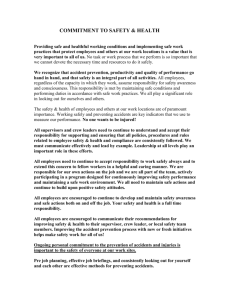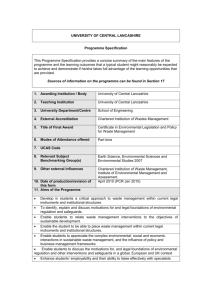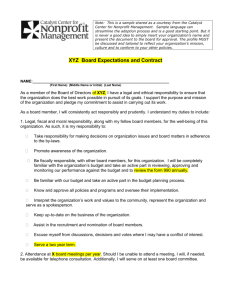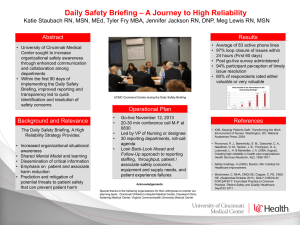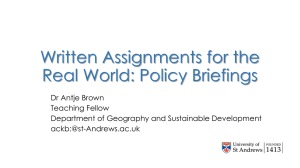Internal.Communications Standards
advertisement
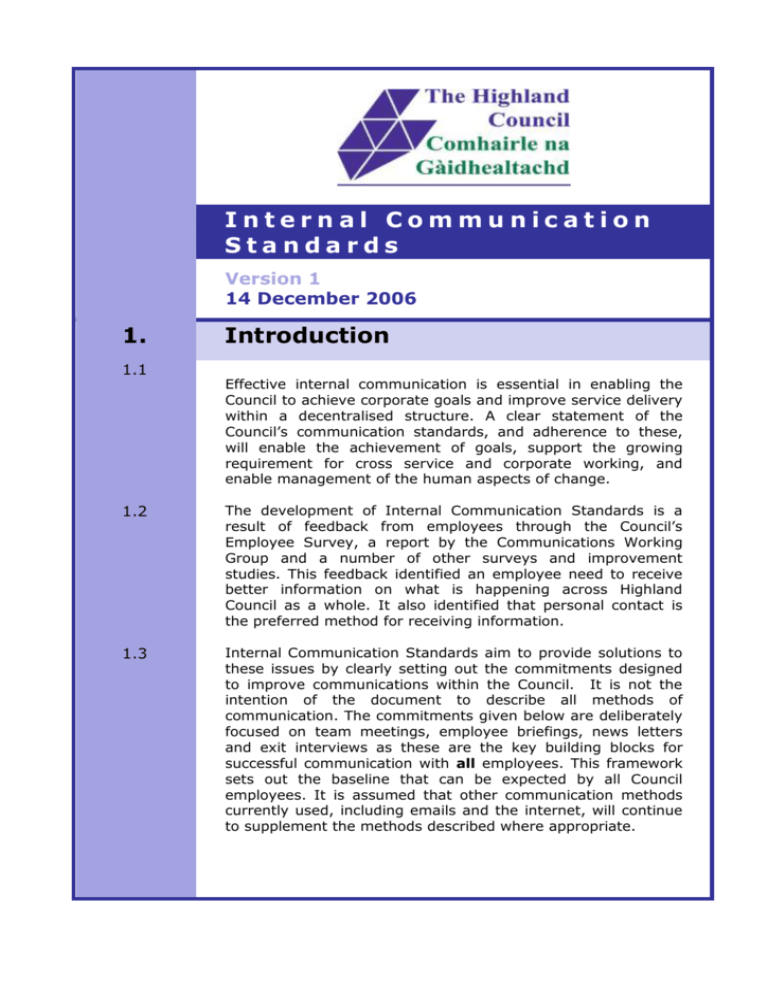
Internal Communication Standards Version 1 14 December 2006 1. 1.1 Introduction Effective internal communication is essential in enabling the Council to achieve corporate goals and improve service delivery within a decentralised structure. A clear statement of the Council’s communication standards, and adherence to these, will enable the achievement of goals, support the growing requirement for cross service and corporate working, and enable management of the human aspects of change. 1.2 The development of Internal Communication Standards is a result of feedback from employees through the Council’s Employee Survey, a report by the Communications Working Group and a number of other surveys and improvement studies. This feedback identified an employee need to receive better information on what is happening across Highland Council as a whole. It also identified that personal contact is the preferred method for receiving information. 1.3 Internal Communication Standards aim to provide solutions to these issues by clearly setting out the commitments designed to improve communications within the Council. It is not the intention of the document to describe all methods of communication. The commitments given below are deliberately focused on team meetings, employee briefings, news letters and exit interviews as these are the key building blocks for successful communication with all employees. This framework sets out the baseline that can be expected by all Council employees. It is assumed that other communication methods currently used, including emails and the internet, will continue to supplement the methods described where appropriate. 1.4 Internal Communications Standards set out a number of key commitments to effectively manage communication with employees. Communication is a two-way process and every employee should be aware of their responsibility to actively engage in the communication process. 2. Principles 2.1 2.2 2.3 2.4 2.5 All Service Plans will state a clear commitment to the successful implementation of the Internal Communication Standards. All employees should receive information that is important to them to carry out their jobs and operate effectively within the Council. Effective communication depends on action by the sender and the receiver. It is a manager’s responsibility to encourage employees to engage in the communication process and provide feedback. It is the employees’ responsibility to contribute to this process and seek information. Managers should create an open and informative culture where all employees are encouraged to seek and give information. Not all feedback will necessarily be acted on but all views, concerns and ideas for improvement will be taken seriously and considered. Communication should be relevant, consistent, and free from jargon and shared at an appropriate time. 2.6 Corporate and Service communications will be designed so as not to disadvantage any group of employees. (For example those without access to email). 2.7 The commitments made in the Internal Communication Standards will be reviewed on a regular basis to ensure continuous improvements are made in internal communications. 2.8 Certain exercises involving proposed changes that might affect employees or their working environments will be managed using the Council’s Change Management Guidelines and will require specific communication plans. These plans will be developed in consultation with employees and their representatives, will be guided by the principles and standards outlined in this document and will be managed through the communication and consultation arrangements agreed with the trade unions. 3. Management Commitments Commitment: Responsible: 3.1 Employees will complete the Council’s Staff Induction Programme on joining the Council. All Managers 3.2 Employees will complete the Council’s Staff Induction Review Programme every three years. (To be developed by the Employee Development Manager). All Managers 3.3 Employees will have a relevant Personal Development Plan reviewed at least every 12 months All Managers 3.4 Operational Plans in support of the Corporate and Service Plans will be discussed with all employees. Heads of Service 3.5 Employees will receive a briefing of relevant business discussed at Highland Council Senior Management Team meetings. This briefing will be complemented by information on Service, Area and local issues by Service Managers and will be delivered by newsletter, email or face to face. Minutes of Senior Management Team and Weekly Business Team will be published on the Council’s Intranet. Public Relations Manager complemented by all Managers 3.6 The Chief Executive will brief Council Managers on a face to face basis about current and forthcoming strategic issues every 6 months. The will be complemented by a management newsletter in the intervening quarters. Chief Executive/ Relations Manage Public 3.7 Heads of Service will make arrangements to encourage all employees to contribute to the Service and Operational planning process. Heads of Service 3.8 Managers will meet with employee teams to discuss work progress, issues and suggested improvements at least every 6 weeks. The Council will encourage employees to provide feedback on aspects of their employment with the Council by contributing to an Employee Survey every 2 years. All Managers Managers will encourage employees to provide feedback on aspects of their employment with the Council by contributing to an exit interview on leaving the Council. (Policy to be implemented by the Head of Personnel). All Managers 3.9 3.10 Assistant Chief Executive 4. Training 4.1 Effective communication requires particular skills. Chairing and facilitation of meetings, the role of the manager and employee in communication and video conferencing have been identified as training priorities. Training resources will be made available to address individual needs as these are identified through the Personal Development Plan process. 5. Monitoring, Evaluation and Review In order to evaluate the implementation of the Internal Communication Standards it is important that the quality and quantity of communication is measured against the commitments set out in section 3. Key Indicator: Measurement: 5.1 All employees are fully informed or fairly well informed about issues relating to their Service and the Council as a whole. Employee feedback will be collected through the Employee Survey. 5.2 All employees receive a summary of relevant information from senior management meetings. 5.3 All new employees have completed the Council Induction Programme. 5.4 All employees have had a PDP review within the past 12 months. 5.5 All employees relevant details operational plan. 5.6 understand from the All employees participate in appropriate team meetings and understand their responsibilities as a communicator. (a) Service Directors will provide details of their employee briefing structure in their Service plans. (b) Employee feedback will be collected through the Employee Survey. Service Directors will provide details of the number of employees that have completed the Induction Programme as part of the Quarterly Service Performance Review. Service Directors will provide details of the number of employees that have completed their PDP programme in the past 12 months as part of the Quarterly Service Performance Review. (a) Service Directors will provide details of their methods for communicating plans to employees in their Service plans. (b) Employee feedback will be collected through the Employee Survey. Service Directors will provide details of their team meeting structure in their Service Plans. 5.7 All employees leaving the Council take part in an exit interview. 6. Consultation 6.1 Service Directors will provide details of the number of employees that have left and completed an exit interview as part of the Quarterly Service Performance Review. Consultation with employees and trades unions on work related matters relating to contractual issues or matter covered by collective agreements will be carried out under a separate consultation framework and in line with the Council’s Change Management Guidelines. 7. Guidance 7.1 Employee Briefings: Employee briefings are the method by which Senior Managers communicate corporate, Service and local issues to all employees. Information included in the briefing can be delivered by newsletter, email or in person as suits the need of the Service. Alternatively employee briefing can be delivered at team meetings. Employee briefings are an example of top down provision of information. 7.2 Team Meetings: Team meetings are the methods by which line managers communicate with their employees on issues that immediately affect their work. These include work progress, health and safety issues, work load, issues and suggestions for improvements. Communication at team meetings must be delivered in person. The size of a team meeting will be dependent on the needs of the Service. Team meetings are an example of two way communication. 7.3 The following documents, available on the Council Intranet or from Area Personnel Officers, provide further guidance. Guidance on Employee Briefings (To be prepared) Guidance on Team Meetings (To be prepared) Employee Induction Personal Development Plans Exit Interviews Report of the Communications Working Group




